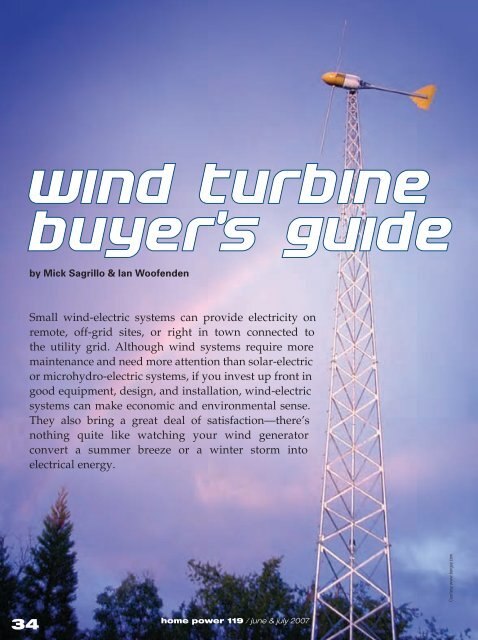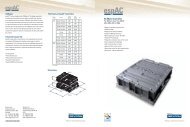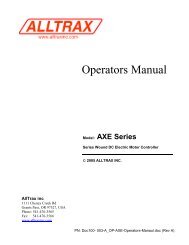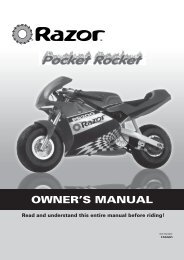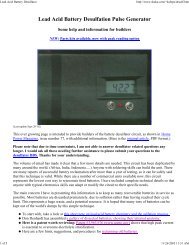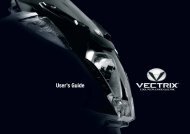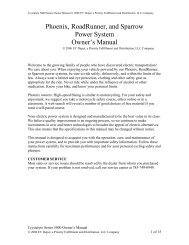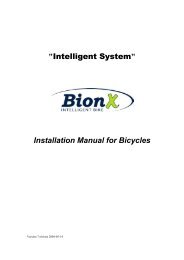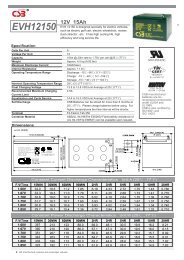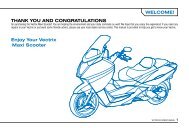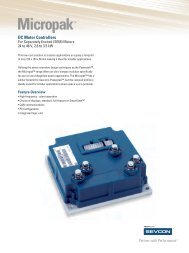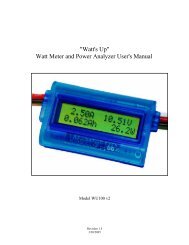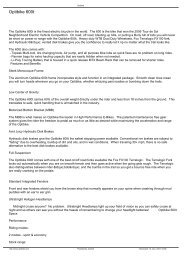Wind Turbine Buyers Guide - RENEW Wisconsin
Wind Turbine Buyers Guide - RENEW Wisconsin
Wind Turbine Buyers Guide - RENEW Wisconsin
Create successful ePaper yourself
Turn your PDF publications into a flip-book with our unique Google optimized e-Paper software.
y Mick Sagrillo & Ian WoofendenSmall wind-electric systems can provide electricity onremote, off-grid sites, or right in town connected tothe utility grid. Although wind systems require moremaintenance and need more attention than solar-electricor microhydro-electric systems, if you invest up front ingood equipment, design, and installation, wind-electricsystems can make economic and environmental sense.They also bring a great deal of satisfaction—there’snothing quite like watching your wind generatorconvert a summer breeze or a winter storm intoelectrical energy.Courtesy www.bergey.com34home power 119 / june & july 2007
wind turbines“Small wind,” in our definition, starts with turbineswith rotors (turbine blades and hub) that are about 8 feet indiameter (50 square feet of swept area). These turbines maypeak at about 1,000 watts (1 kilowatt; KW), and generate about75 kilowatt-hours (KWH) per month with a 10 mph averagewind speed. <strong>Turbine</strong>s smaller than this may be appropriatefor sailboats, cabins, or other applications that require onlya small amount of electricity. But if you want a significantamount of energy, you need a rotor with significant sweptarea—it is, after all, the wind turbine’s “collector.”On the other end of the “small wind” scale, it’s reasonableto include turbines with rotors up to 56 feet in diameter(2,500 square feet of swept area). These turbines may peak atabout 90,000 watts (90 KW), and generate 3,000 to 5,000 KWHper month at a 10 mph average wind speed. <strong>Turbine</strong>s of this scaleare appropriate for very large homes, farms, small businesses,schools, or institutions that use a lot of electricity, or for heatingapplications, village power, and other major energy uses.In between 8 feet and 56 feet are various sizes of turbinesthat can accommodate a variety of energy appetites. It’scrucial that you have an accurate idea of what your energyusage is and the wind resource available at your site, so youcan match the turbine’s output to your energy needs.Sizing a wind-electric system is quite different thansizing a solar-electric (PV) system. With a PV system, spacepermitting, you can add capacity either as your needs grow,or as you can afford it. With a wind-electric system, this issimply not the case. A wind turbine is not incremental. Nordo people typically add more wind turbines and towers asmoney becomes available. Because wind is more cost effectiveas you increase in system size, most people put up only onewind turbine, with the intent of offsetting a large percentageof their electric bill or, in off-grid systems, meeting most orall of their electrical energy requirements.System ComponentsThe wind generator (or “turbine”) is only one componentin a wind-electric system, and very often is not even themost expensive component. You need all of the necessarycomponents to have a functional system. Plan ahead to buyquality components properly matched to each other and toyour energy use. A complete wind-electric system includes:• <strong>Turbine</strong>—generates electricity using the wind’s energy• Tower—supports the turbine, getting it up out of theturbulent zone created by trees and buildings, and exposesthe turbine to much more “fuel”• Wiring and conduit—carries the electricity down thetower and to power-conditioning equipment• Controller/Electronics—controls charging of battery orinput to inverter• Batteries—used for storage in off-grid systems or grid-tiedsystems with battery backup• Inverter—converts direct current (DC) electricity frombatteries or rectifier to alternating current (AC) for homeuse or “storage” on the utility grid• Metering—allows user to understand and manage systemoperationThe diameter of a wind turbine’s rotordefines its swept area, the most importantvariable in the final energy generated.In the wind turbine specifications on thefollowing pages, the blue circles representthe relative swept area of each turbine,drawn to scale.1 inch=10 feetThe world is full of small wind generators. Chinesemanufacturing numbers dwarf U.S. production, andEuropean companies make dozens of models as well.This article covers home-scale wind generators, eithermanufactured or imported, that are supported in NorthAmerica. The turbines profiled are readily available tobuyers in the United States and Canada. And service,parts, and support are also available, either directlythrough the manufacturers, or through dedicatedimporters.Other machines have been imported into North Americain limited numbers, by individual owners or companies.Some of these may end up having long-term supportfrom North American importers. Others may not. Wesuggest that you approach buying these machines withcaution. If you’re patient and willing to take a bit of risk,you may want to try one of these. You might end up witha real winner, or you may be stuck waiting for parts or aresponse from a distant manufacturer.Home-scale wind generators come and go. We do notknow enough about the quality of the equipment northe responsiveness of the manufacturers listed below tomake any firm recommendations. Our non-exhaustivelist of other turbines we know about in North Americaincludes:• Aircon—a German machine with a 23-foot-diameter rotor• Énergie PGE—from Canada, 36-foot-diameter rotor• Iskrawind—a UK machine with an 18-foot-diameter rotor• Tulipo—a Dutch machine with a 16-foot-diameter rotor• Various other machines, including Aeromax Lakota,Air-O-Power, Anhua, Exmok, E-Mark, Gryphon,Trillium, and CycloneOther machines are under development. It’s very hardto predict what will actually come to market, and howthey will perform. A few look promising to us. One isa new induction generator design from Earth <strong>Turbine</strong>s,a new company founded by David Blittersdorf of NRGSystems, which has long experience in wind monitoring.Another is the Endurance, developed by an engineeringteam in Utah, and also using an induction design. Applystandard cautions if considering these or any other newturbine—there’s nothing like a real-world track record!www.homepower.com35
wind turbinesManufacturer: 405-364-4212 • www.bergey.comManufacturer: 503-538-8298 • www.abundantre.comARE 110Rotor diameter: 11.8 feet (3.6 m)Swept area: 110 square feet (10.2 m 2 )Rated rpm: 340Predicted energy output at average wind speeds: 135 KWH permonth at 8 mph; 262 at 10 mph; 420 at 12 mphApplication: Batteryless grid-tie or 48 VDC battery chargingPrice (MSRP): $11,500 for ARE 110 wind turbine, SMA <strong>Wind</strong>yBoy inverter, voltage clamp, and resistor load; $8,870 for 48 VDCturbine, charge controller, and diversion loadWarranty: 5 yearsARE 442Rotor diameter: 23.6 feet (7.2 m)Swept area: 442 square feet (41 m 2 )Rated rpm: 140Predicted energy output at average wind speeds: 623 KWH permonth at 8 mph; 1,171 at 10 mph; 1,831 at 12 mphApplication: Batteryless grid-tie; battery charging system underdevelopmentPrice (MSRP): $36,000 for turbine, two SMA <strong>Wind</strong>y Boy 6000Uinverters, voltage clamp, and resistor loadsWarranty: 5 yearsBergey XL.1Rotor diameter: 8.2 feet (2.5 m)Swept area: 53 square feet (4.9 m 2 )Rated rpm: 450Predicted energy output at average wind speeds: 55 KWH permonth at 8 mph; 115 at 10 mph; 188 at 12 mphApplication: 24 VDC battery chargingPrice (MSRP): $2,590 without controller or inverterWarranty: 5 yearsBergey ExcelRotor diameter: 23 feet (7 m)Swept area: 415 square feet (38.6 m 2 )Rated rpm: 300Predicted energy output at average wind speeds (batterycharging/batteryless grid-tie): 240/340 KWH per month at 8mph; 520/680 at 10 mph; 900/1,090 at 12 mphApplication: Batteryless grid-tie; 48, 120, 240 VDC batterychargingPrice (MSRP): $22,900 for BWC XL-R, 48 VDC; $21,900 for BWCXL-R, 120 or 240 VDC; $27,900 for BWC XL-S, 240 VAC withinverterWarranty: 5 yearsARE 110 ARE 442 Bergey XL.1 Bergey Excel<strong>Wind</strong> <strong>Turbine</strong> BasicsBoiled down to its simplest principles, a wind generator’srotating blades convert the wind’s kinetic energy intorotational momentum in a shaft. The rotating shaft turnsan alternator, which makes electricity. This electricity istransmitted through wiring down the tower to its end use.The blades use engineered airfoils, matched to thealternator, that capture the wind’s energy. Most modern windgenerators use three blades, the best compromise betweenthe highest efficiency possible (one blade) and the balancethat comes with multiple blades. Together, the blades andthe hub they are attached to are termed the “rotor,” which isthe “collector” of the system, intercepting winds that pass by.Most turbines on the market today are upwind machines—their blades are on the windward side of the tower. A fewdownwind machines are available, but neither configurationhas a clear performance advantage over the other.In most small-scale designs, the rotor is connected directly tothe shaft of a permanent magnet alternator, which creates wild,three-phase AC. Wild, three-phase electricity means that thevoltage and frequency vary continuously with the wind speed.They are not “fixed” like the 60 Hz, 120 VAC electricity comingout of common household outlets. The wild output is rectifiedto DC to either charge batteries or feed a grid-synchronousinverter. In most designs up to 15 KW in peak capacity, therotor is usually connected directly to the alternator, whicheliminates the additional maintenance of gears. In systems 20KW and larger, as well as some smaller wind systems (like theEndurance, Tulipo, or Aircon), a gearbox is used to increasealternator speed from a slower turning rotor.The blades must turn to face the wind, so a yaw bearingis needed, allowing the wind turbine to track the winds asthey shift direction. The tail directs the rotor into the wind.Some sort of governing system limits the rotor rpm as wellas generator output to protect the turbine from high winds. Ashutdown mechanism is also useful to stop the machine whennecessary, as during an extreme storm, when you do not needthe energy, or when you want to service the system.36home power 119 / june & july 2007
wind turbinesImporters:Pine Ridge Products LLC • 406-738-4283 •www.pineridgeproducts.comSolacity • 613-686-4618 • www.solacity.comEoltec 6 KWRotor diameter: 18.4 feet (5.6 m)Swept area: 265 square feet (24.6 m 2 )Rated rpm: 245Predicted energy output at average wind speeds: 294 KWH permonth at 8 mph; 558 at 10 mph; 892 at 12 mphApplication: Batteryless grid-tiePrice (MSRP): $25,200 with inverterWarranty: 5 yearsImporter: DC Power Systems • 800-967-6917 •www.dcpower-systems.comKestrel 800Rotor diameter: 7 feet (2.1 m)Swept area: 38.5 square feet (3.6 m 2 )Rated rpm: 1,000Predicted energy output at average wind speeds: 40 KWH permonth at 8 mph; 80 at 10 mph; 125 at 12 mphApplication: Batteryless grid-tie or 12, 24, 48 VDC batterychargingPrice (MSRP): $1,995 without controller or inverterWarranty: 5 yearsKestrel 1000Rotor diameter: 10 feet (3 m)Swept area: 79 square feet (7.3 m 2 )Rated rpm: 650Predicted energy output at average wind speeds: 75 KWH permonth at 8 mph; 130 at 10 mph; 210 at 12 mphApplication: 12, 24, 48 VDC battery chargingPrice (MSRP): $2,950 without controller or inverterWarranty: 5 yearsKestrel 3000Rotor diameter: 12.5 feet (3.8 m)Swept area: 120 square feet (11.2 m 2 )Rated rpm: 500Predicted energy output at average wind speeds: 130 KWH permonth at 8 mph; 230 at 10 mph; 375 at 12 mphApplication: Batteryless grid-tie or 48 VDC battery chargingPrice (MSRP): $8,400 with controller and dump load, withoutinverterWarranty: 5 yearsEoltec 6 KW Kestrel 800 Kestrel 1000 Kestrel 3000Understanding the Ratings<strong>Wind</strong> turbine rating is a tricky affair. While solar-electricmodule or microhydro-electric turbine production can bepredicted fairly realistically based on rated output, this numberis very misleading with wind turbines. Why? Because ratedoutput is pegged to a particular wind speed, and differentmanufacturers use different wind speeds to determine ratedoutput. Also, the power available in the wind varies with thecube of its speed, so small increases in wind speed result inlarge increases in power available to the rotor. A 10 percentincrease in wind speed yields a 33 percent increase in poweravailable in the wind. Conversely, this means that a turbinerated at 1,000 watts at 28 mph might produce only 125 watts orless at half that wind speed, 14 mph.So what’s a wind turbine buyer to do? Ignore the peakoutput and the power curve. Look for the monthly or annualenergy numbers for the turbine, estimated for the averagewind speed you expect or measure at your site. These willbe given in KWH per month (or year) in the manufacturer’sspecifications for each turbine. Energy is what you’re after,not peak power! If, for example, you are looking for a turbinethat can produce 300 KWH per month, and you know thatyou have a 10 mph average wind speed at the proposedturbine height, you can shop for a turbine that is predicted togenerate that much energy in that average wind speed.If you can’t get energy production estimates fromthe manufacturer or a turbine owner, look for a differentmanufacturer. This is basic information that any manufacturershould supply. However, knowing a turbine’s swept areamay also help you calculate the annual energy output forthe wind turbine. All other things being equal, “there’s noreplacement for displacement.” Hugh Piggott gives a roughformula for calculating output based on average wind speedand swept area in his HP102 article (see Access). Jim Greenat the National Renewable Energy Lab (NREL) developeda similar formula: annual energy output (AEO) in KWH =0.01328 x rotor diameter (ft.) squared x average wind speed(mph) cubed.www.homepower.com37
wind turbinesImporters:Lake Michigan <strong>Wind</strong> & Sun • 920-743-0456 • www.windandsun.comSolar <strong>Wind</strong> Works • 877-682-4503 • www.solarwindworks.comProven WT 0.6Rotor diameter: 8.4 feet (2.6 m)Swept area: 55 square feet (5.1 m 2 )Rated rpm: 500Predicted energy output at average wind speeds: 42 KWH permonth at 8 mph; 83 at 10 mph; 124 at 12 mphApplication: Batteryless grid-tie; 12, 24, 48 VDC battery chargingPrice (MSRP): $4,870 without controller or inverterWarranty: 2 years; extended warranty availableProven WT 2.5Rotor diameter: 11.1 feet (3.4 m)Swept area: 97 square feet (9 m 2 )Rated rpm: 300Predicted energy output at average wind speeds: 167 KWH permonth at 8 mph; 293 at 10 mph; 417 at 12 mphApplication: Batteryless grid-tie; 24, 48 VDC battery chargingPrice (MSRP): $9,650 without controller or inverterWarranty: 2 years; extended warranty availableProven WT 6Rotor diameter: 18 feet (5.5 m)Swept area: 254 square feet (23.6 m 2 )Rated rpm: 200Predicted energy output at average wind speeds: 417 KWH permonth at 8 mph; 667 at 10 mph; 1,083 at 12 mphApplication: Batteryless grid-tie or 48 VDC battery chargingPrice (MSRP): $20,500 without controller or inverterWarranty: 2 years; extended warranty availableProven WT 15Rotor diameter: 29.5 feet (9 m)Swept area: 683 square feet (63.5 m 2 )Rated rpm: 150Predicted energy output at average wind speeds: 777 KWH permonth at 8 mph; 1,451 at 10 mph; 3,080 at 12 mphApplication: Batteryless grid-tie or 48 VDC battery chargingPrice (MSRP): $39,340 without controller or inverterWarranty: 2 years; extended warranty availableProven WT 0.6 Proven WT 2.5 Proven WT 6 Proven WT 15Other ConsiderationsA turbine’s revolutions per minute (rpm) at its rated windspeed can give you some idea of the relative aerodynamicsound of the machine, and also speaks to longevity. Slowerturningwind turbines tend to be quieter and last longer.High rpm machines wear out components, such as bearings,much faster. In addition, the faster blades move through theair, the greater the possibility that they will waste some ofthat energy as sound from the blades.Some manufacturers make only battery-chargingmachines, and may offer a variety of turbine voltages. Othersproduce machines intended to connect to grid-synchronousinverters without batteries. One machine even includes aninverter integrated with the turbine itself. Make sure you’rebuying a machine that is appropriate for your intended use.Make Your ChoiceTrying to keep an inexpensive wind generator running canbe an uphill battle that you’ll soon tire of. But expect to paymore for a better machine—it’s a tough job to design andmanufacture a long-lasting, small-scale wind generator.The bottom line: Buy a turbine that has a very good trackrecord and a good warranty—five years is preferable butnot always available in the small wind industry. A warrantyis one indication of the manufacturer’s confidence in theirproduct, and their intention to stand behind it.Real-world reports from users carry even more weightthan a warranty, so search for people who own the modelof turbine you’re considering buying, and get the straightscoop from them about performance, durability, reliability,and maintenance issues.Note that a number of the wind turbines listed here arerelatively new introductions with not very much customerrun-time in North America. These turbines include theARE, Eoltec, Kestrel, and Skystream. We recommendthat you contact either your local wind turbine installer,or the manufacturers or importers and find out howmany of these machines are actually operating in North38home power 119 / june & july 2007
wind turbinesManufacturer: 928-779-9463 • www.windenergy.comWhisper 100Rotor diameter: 7 feet (2.1 m)Swept area: 38.5 square feet (3.6 m 2 )Rated rpm: 1,200Predicted energy output at average wind speeds: 30 KWH permonth at 8 mph; 65 at 10 mph; 100 at 12 mphApplication: 12, 24, 36, 48 VDC battery chargingPrice (MSRP): $2,475 with controllerWarranty: 5 yearsWhisper 200Rotor diameter: 9 feet (2.7 m)Swept area: 63.5 square feet (5.9 m 2 )Rated rpm: 1,100Predicted energy output at average wind speeds: 60 KWH permonth at 8 mph; 125 at 10 mph; 190 at 12 mphApplication: 12, 24, 36, 48 VDC battery chargingPrice (MSRP): $2,995 with controllerWarranty: 5 yearsSkystream 3.7Rotor diameter: 12 feet (3.6 m)Swept area: 113 square feet (10.5 m 2 )Rated rpm: 325Predicted energy output at average wind speeds: 100 KWH permonth at 8 mph; 240 at 10 mph; 380 at 12 mphApplication: Batteryless grid-tie, or battery charging throughbattery-based inverter (not included) AC inputPrice (MSRP): $5,400, including turbine-integrated batterylessinverterWarranty: 5 yearsWhisper 500Rotor diameter: 15 feet (4.6 m)Swept area: 176 square feet (16.4 m 2 )Rated rpm: 800Predicted energy output at average wind speeds: 170 KWH permonth at 8 mph; 330 at 10 mph; 538 at 12 mphApplication: Batteryless grid-tie; 24, 32, 48 VDC battery chargingPrice (MSRP): $7,675 for battery charging with controller;$12,125 for grid tied with inverterWarranty: 5 yearsWhisper 100 Whisper 200 Skystream 3.7 Whisper 500America. Then contact the owners, and inquire about theirexperience and satisfaction with both the machine and themanufacturer or importer.When you look at prices, keep in mind that just buying awind turbine will not get you any wind-generated electricity.You’ll also need most or all of the components mentionedearlier. Also budget for equipment rental, like a backhoe andcrane, concrete and rebar, electrical components, shipping,and sales tax. Unless you do all of the work yourself, alsofactor in installation labor expenses. These costs can add upsignificantly, so make sure that you research and understandall of the associated expenses before committing to a purchase.Many people are quite surprised to learn that the wind turbinecost can range from only 10 percent to as much as 40 percent ofthe entire wind system’s expenses.Small-scale wind energy is not for the half-hearted,uninvolved, or uncommitted, and probably not for folkswho never change the oil in their vehicles (or are willing tospend the bucks to hire someone to do the tower work). TheNorth American landscape is littered with failed installations:Designs not fully thought-out or tested, machines boughtbecause they were cheap, and installations that required moretime and money for repairs than they ever yielded in electricitygenerated. Many of the failures were the result of wishfulthinking and too little research. That said, there are tens ofthousands of happy wind-electric system owners. These ownersdid their homework—purchasing, designing, and installingrugged and well-thought-out systems on adequately sizedtowers. In addition, they are either committed to maintainingthe systems, or to hiring someone to do this regular work.While many first-time wind turbine buyers may belooking for a bargain, second-time wind turbine buyersare seeking the most rugged machine they can afford. Youcan avoid a painful “learning experience” by focusing ondurability, production, warranty, and track record, and noton price alone, or on peak output. You don’t want to dependon the low bidder for something as important to you as yourlong-term energy investment.www.homepower.com39
wind turbinesRebuilders:Energy Maintenance Service LLC • 605-272-5398 •www.energyms.comHalus Power Systems • 510-780-0591 • www.halus.comVestas V-15Rotor diameter: 50 feet (15 m)Swept area: 1,964 square feet (182 m 2 )Rated rpm: 53Predicted energy output at average wind speeds: N/A at 8 mph;3,354 KWH per month at 10 mph; 5,371 at 12 mphApplication: Batteryless grid-tiePrice (MSRP): $140,000 installed on 110-foot towerWarranty: 1 year; extended warranties availableVestas V-17Rotor diameter: 56 feet (17 m)Swept area: 2,462 square feet (229 m 2 )Rated rpm: 45–50Predicted energy output at average wind speeds: N/A at 8 mph;5,060 KWH per month at 10 mph; 8,198 at 12 mphApplication: Batteryless grid-tiePrice (MSRP): $180,000 installed on 132-foot towerWarranty: 1 year; extended warranty availableManufacturer: 952-447-6064 • www.windturbine.netWTIC 31-20Rotor diameter: 31 feet (9.5 m)Swept area: 754 square feet (70 m 2 )Rated rpm: 175Predicted energy output at average wind speeds: 819 KWH permonth at 8 mph; 1,644 at 10 mph; 2,691 at 12 mphApplication: Batteryless grid-tiePrice (MSRP): $33,900 with inverterWarranty: 1 year; extended warranty availableVestas V-15 Vestas V-17WTIC 31-20Your <strong>Wind</strong> <strong>Turbine</strong>?In our next article, we’ll discuss system design and theturbine selection process in more detail. Meanwhile, weencourage you to start with an energy analysis of yourhome—find out how many kilowatt-hours you need andhow you can reasonably pare that number down! Next, findout what your wind resource is—guessing on this will makeyour whole system design a guess. And when it’s time to buy,choose a rugged turbine that will produce what you expect itto, and do that for years to come.Note: All numbers are provided by manufacturers or extrapolatedfrom their data, since no comprehensive, independent testing data isavailable. <strong>Turbine</strong> performance may vary at your site.AccessMick Sagrillo, E3971 Bluebird Rd., Forestville, WI 54213 •msagrillo@wizunwired.netIan Woofenden, PO Box 1001, Anacortes, WA 98221 •ian.woofenden@homepower.com“Anatomy of a <strong>Wind</strong> <strong>Turbine</strong>,” Ian Woofenden & HughPiggott, HP116“<strong>Wind</strong> Generator Tower Basics,” Ian Woofenden, HP105“Estimating <strong>Wind</strong> Energy,” Hugh Piggott, HP102Third Annual Small <strong>Wind</strong> Power Conference: A Gatheringof Installers, Manufacturers, Dealers & Distributors • June12-13, ’07 • Holiday Inn Hotel & Convention Center, StevensPoint, WI • For information, contact Amy Heart at theMREA • 715-592-6595 • amy@the-mrea.org40home power 119 / june & july 2007


